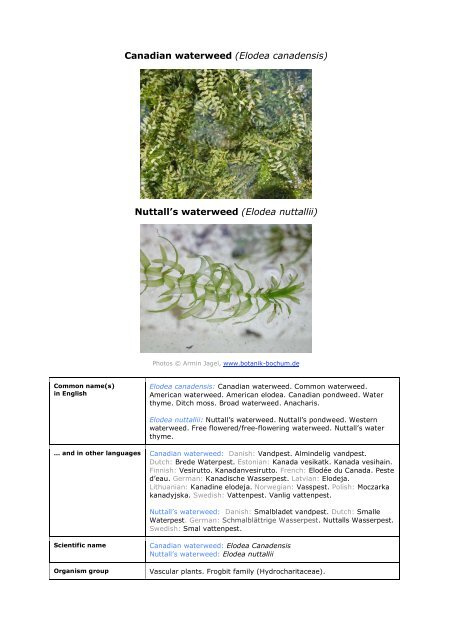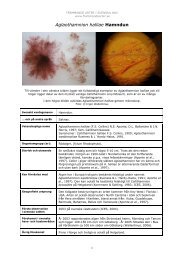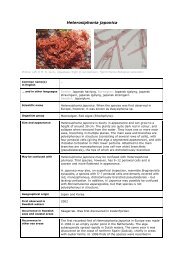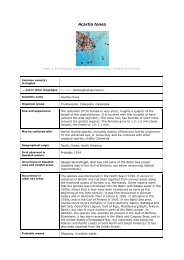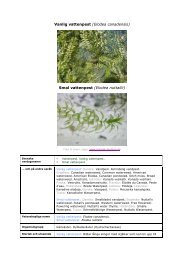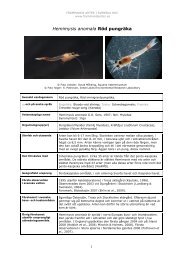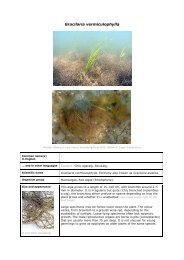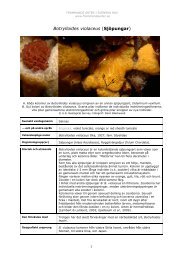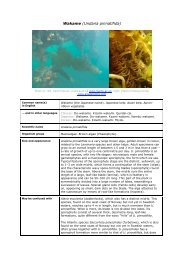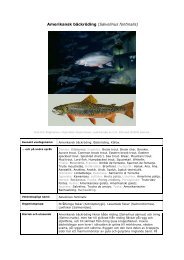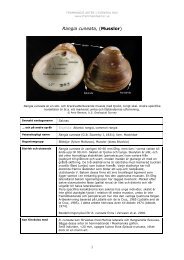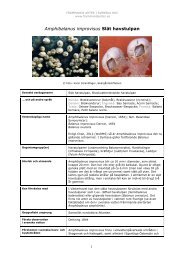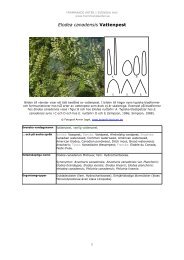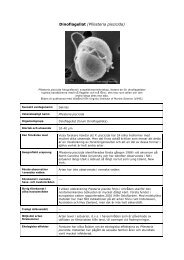Elodea nuttallii
Elodea nuttallii
Elodea nuttallii
Create successful ePaper yourself
Turn your PDF publications into a flip-book with our unique Google optimized e-Paper software.
Canadian waterweed (<strong>Elodea</strong> canadensis)<br />
Nuttall’s waterweed (<strong>Elodea</strong> <strong>nuttallii</strong>)<br />
Photos © Armin Jagel, www.botanik-bochum.de<br />
Common name(s)<br />
in English<br />
<strong>Elodea</strong> canadensis: Canadian waterweed. Common waterweed.<br />
American waterweed. American elodea. Canadian pondweed. Water<br />
thyme. Ditch moss. Broad waterweed. Anacharis.<br />
<strong>Elodea</strong> <strong>nuttallii</strong>: Nuttall’s waterweed. Nuttall’s pondweed. Western<br />
waterweed. Free flowered/free-flowering waterweed. Nuttall’s water<br />
thyme.<br />
… and in other languages<br />
Canadian waterweed: Danish: Vandpest. Almindelig vandpest.<br />
Dutch: Brede Waterpest. Estonian: Kanada vesikatk. Kanada vesihain.<br />
Finnish: Vesirutto. Kanadanvesirutto. French: Elodée du Canada. Peste<br />
d’eau. German: Kanadische Wasserpest. Latvian: Elodeja.<br />
Lithuanian: Kanadine elodeja. Norwegian: Vasspest. Polish: Moczarka<br />
kanadyjska. Swedish: Vattenpest. Vanlig vattenpest.<br />
Nuttall’s waterweed: Danish: Smalbladet vandpest. Dutch: Smalle<br />
Waterpest. German: Schmalblättrige Wasserpest. Nuttalls Wasserpest.<br />
Swedish: Smal vattenpest.<br />
Scientific name<br />
Organism group<br />
Canadian waterweed: <strong>Elodea</strong> Canadensis<br />
Nuttall’s waterweed: <strong>Elodea</strong> <strong>nuttallii</strong><br />
Vascular plants. Frogbit family (Hydrocharitaceae).
Size and appearance<br />
Canadian waterweed: Has long, trailing stems that can grow to a<br />
couple of metres in length. The leaves, which are 6–15 mm long and<br />
1.5–4 mm wide, are arranged in whorls along the stem. The plant has<br />
white, thread-like roots. The white, single-sex flowers appear from<br />
July to September.<br />
Nuttall’s waterweed: Like Canadian waterweed, has trailing, metrelong<br />
stems. As in that species, the leaves are arranged in whorls, but<br />
here they are slightly shorter (6–13 mm) and appreciably narrower<br />
(no more than 1.5 mm), and they may be a somewhat paler green. In<br />
general, plants of this species are somewhat smaller and more<br />
“delicate” than Canadian waterweed.<br />
Both species: Male and female flowers are produced on different<br />
plants. So far, only female plants of the two species have been found<br />
in Europe. The species reproduce vegetatively by means of loose<br />
fragments and stem tips that disperse by water or are carried to new<br />
sites by birds or humans. Even tiny fragments can develop into new<br />
plants.<br />
May be confused with<br />
The two species may be confused with each other, but, as indicated<br />
above, Canadian waterweed (<strong>Elodea</strong> canadensis) has broader leaves<br />
than Nuttall’s (E. <strong>nuttallii</strong>). In Canadian waterweed, the leaves of the<br />
stem tip are broad and tongue-like, rather than narrow and strongly<br />
recurved. Nuttall’s waterweed has a more freely branched stem.<br />
Another difference between the species is that in Nuttall’s waterweed<br />
the male flowers (which admittedly are rarely produced) break off and<br />
float to the surface. Nuttall’s waterweed is still considerably rarer than<br />
Canadian waterweed, but seems to be spreading ever more widely in<br />
Europe and may even, in places, have the potential to outcompete its<br />
relative.<br />
A closely related species, Brazilian elodea or Brazilian waterweed<br />
(Egeria densa), is often sold for use in aquaria.<br />
Geographical origin<br />
Canadian waterweed: North America: Canada.<br />
Nuttall’s waterweed: North America (named after Thomas Nuttall, who<br />
studied the flora of the American West in the early 19th century).<br />
First observed in<br />
Swedish waters<br />
Occurrence in<br />
Swedish waters<br />
Canadian waterweed: 1871, in ponds in the Uppsala area.<br />
Nuttall’s waterweed: 1991, at Ängby near Stockholm.<br />
Canadian and Nuttall’s waterweed are freshwater plants, and do not<br />
occur in salt water or in brackish water too strongly affected by salt<br />
water (see below regarding habitats). Canadian waterweed is to be<br />
found, however, in Swedish and Finnish coastal waters of the Gulf of<br />
Bothnia, for instance in confined inlets in areas where marked<br />
postglacial crustal uplift is occurring.<br />
In fresh waters, Canadian waterweed is found widely across Sweden,<br />
from Skåne in the south to Dalarna in the north, with some<br />
occurrences even further north. Less is known about how common<br />
Nuttall’s waterweed is, but the species has been found in various<br />
freshwater bodies in Skåne, Västergötland and Norrbotten. In Lake<br />
Mälaren, this species is more abundant than Canadian waterweed.<br />
Occurrence in other<br />
areas (coastal or<br />
inland waters)<br />
Canadian waterweed: Was introduced to Europe from North America<br />
around 1840. It is reported to have been discovered for the first time<br />
in Europe in 1836, in a pond in Ireland, and six years later finds were<br />
made in Britain (Scotland). The first find in Germany was in 1859, in
the vicinity of Berlin. Today the species occurs throughout Germany,<br />
but is beginning to be supplanted by its relative Nuttall’s waterweed.<br />
Canadian waterweed is now also to be found throughout Poland. The<br />
species was first recorded in Denmark in 1870 (and is now established<br />
and common there), in Sweden in 1871 (now established and<br />
common), in Finland in the 1870s (now established and common), but<br />
not until 1925 in Norway. It was discovered in Estonia in 1905 (now<br />
established and common), in Latvia in 1872 (now established and<br />
common), in Lithuania in 1884 (now established and common), and in<br />
European areas of Russia in 1870 (now established and common).<br />
Canadian waterweed has also spread to countries in Asia, to Australia<br />
and New Zealand, and from Europe on into North Africa.<br />
Nuttall’s waterweed: Was probably introduced into Europe from North<br />
America in the 20th century. When the species was first discovered in<br />
Britain in 1914, however, it was identified as Hydrilla verticillata, and a<br />
definite identification of <strong>Elodea</strong> <strong>nuttallii</strong> was not made until 1974. From<br />
the continent of Europe, finds were reported from Belgium in 1939<br />
(with a definite identification in 1955) and the Netherlands in 1941. In<br />
Germany the species was discovered in a botanical garden in 1953,<br />
and has since spread across the country. There are also reports of<br />
finds in Denmark (1974). It is not unlikely that additional finds have<br />
been made, but that they have been mistaken for Canadian<br />
waterweed. Nuttall’s waterweed now appears to be becoming<br />
increasingly widespread, even to the extent of outcompeting Canadian<br />
waterweed.<br />
Probable means<br />
of introduction<br />
Habitat(s) in which<br />
species occurs<br />
Canadian waterweed may have been used in aquaria, which were then<br />
emptied into rivers and lakes. In addition, the species may have<br />
accompanied other plants or timber imported into Europe. Further<br />
dispersal to neighbouring countries, or within countries, can also be<br />
brought about by birds. Movements of recreational craft between<br />
water bodies are another means by which the species can spread.<br />
Canadian and Nuttall’s waterweed are freshwater species, but also<br />
occur in brackish-water areas significantly affected by fresh water<br />
(confined inlets, estuaries). In general, though, Canadian waterweed<br />
and, to an increasing extent, Nuttall’s waterweed are chiefly to be<br />
found in lakes, ponds, slow-moving rivers and wetlands.<br />
Both species are submerged plants. They prefer calcareous, nutrientrich<br />
waters (pH 6.5–10) and sediments, and grow best on firm<br />
substrates with a high mineral content. In eutrophicated waters they<br />
have a competitive advantage over other aquatic plants. They also<br />
contribute to internal nutrient cycling in water bodies, as they take up<br />
nutrients from sediments. These species are tolerant of shade and are<br />
therefore able to survive even in turbid waters. Although they are<br />
freshwater plants, they can cope with salinities of up to 2.5 psu. The<br />
optimum water temperature range is 10–25°C, but both species can<br />
withstand quite cold water. Under a layer of closed, snow-covered ice,<br />
plants can survive even in water at a temperature of just 1–4°C. The<br />
two species tend to grow in relatively shallow water, preferably no<br />
deeper than about 3 m, but Canadian waterweed has been found down<br />
to depths of 16 m. Nuttall’s waterweed seems to be able to grow in<br />
deeper water than Canadian.<br />
Ecological effects Both these <strong>Elodea</strong> species form dense stands – like thick carpets –<br />
that reach all the way to the surface of the water. This compact mass<br />
of plant material prevents penetration of sunlight, changing conditions<br />
for other plants. Animal life, too, is affected by the dense, spreading<br />
stands. In addition, the nutrient status of the water can be altered if<br />
large quantities of biomass from the species are broken down,<br />
exacerbating eutrophication. As they grow, Canadian and Nuttall’s
waterweed can displace other plant species.<br />
Other effects<br />
Additional information<br />
Dense canopies of Canadian and Nuttall’s waterweed cause significant<br />
problems for boat traffic and fisheries. A large abundance of these<br />
species also makes waters unsuitable for bathing and other<br />
recreational uses.<br />
<strong>Elodea</strong> canadensis is also known by several synonyms:<br />
• Anacharis canadensis<br />
• Anacharis canadensis var. planchonii<br />
• <strong>Elodea</strong> brandegae<br />
• <strong>Elodea</strong> ioensis<br />
• <strong>Elodea</strong> linearis<br />
• <strong>Elodea</strong> planchonii<br />
• Helodea canadensis<br />
• Philotria canadensis<br />
• Philotria linearis<br />
For <strong>Elodea</strong> <strong>nuttallii</strong>, too, there are several synonyms:<br />
• Anacharis occidentalis<br />
• Anacharis <strong>nuttallii</strong><br />
• <strong>Elodea</strong> columbiana<br />
• <strong>Elodea</strong> minor<br />
• <strong>Elodea</strong> occidentalis<br />
• Philotria angustifolia<br />
• Philotria minor<br />
• Philotria <strong>nuttallii</strong><br />
• Philotria occidentalis<br />
• Udora verticillata var. minor<br />
FIND OUT MORE: Canadian waterweed (<strong>Elodea</strong> canadensis)<br />
• Swedish Museum of Natural History: (Virtual flora): Vattenpest (<strong>Elodea</strong> canadensis)<br />
In Swedish only<br />
http://linnaeus.nrm.se/flora/mono/hydrocharita/elode/elodcan.html<br />
• North European and Baltic Network on Invasive Alien Species: <strong>Elodea</strong> canadensis<br />
http://www.nobanis.org/speciesInfo.asptaxaID=822<br />
• Wikipedia: Vattenpest (<strong>Elodea</strong> canadensis)<br />
http://sv.wikipedia.org/wiki/Vattenpest<br />
• BioPix: Vattenpest (<strong>Elodea</strong> canadensis)<br />
http://www.biopix.dk/Species.aspLanguage=sv&Searchtext=<strong>Elodea</strong>%20canadensis&Category=Planter<br />
• Baltic Sea Alien Species Database: <strong>Elodea</strong> canadensis<br />
http://www.ku.lt/nemo/directory_details.phpsp_name=<strong>Elodea</strong>+canadensis<br />
• Alien species in Poland: <strong>Elodea</strong> canadensis<br />
http://www.iop.krakow.pl/ias/species.asp83<br />
• European Nature Information System Database (EUNIS): <strong>Elodea</strong> canadensis<br />
http://eunis.eea.europa.eu/species-factsheet.jspidSpecies=186340&idSpeciesLink=186340<br />
• Aquatische Neopyhten in Nordrhein-Westfalen: <strong>Elodea</strong> canadensis<br />
http://www.aquatischeneophyten.de/Webseiten%20NEU/Pflanzenseiten%20neu/<strong>Elodea</strong>%20canadensis.htm<br />
• Botanischer Garten, Ruhr-Universität Bochum: <strong>Elodea</strong> canadensis<br />
http://www.ruhr-uni-bochum.de/boga/html/<strong>Elodea</strong>_canadensis_Foto2.html<br />
• 82 kB: DAEC, Bureau de protection de la nature et du paysage du canton de Fribourg:<br />
Elodée du Canada.<br />
http://www.fr.ch/pna/neophytes/fiches/elodee.pdf<br />
• Ulster Museum Sciences Division: Flora of Northern Ireland: <strong>Elodea</strong> canadensis<br />
http://www.habitas.org.uk/flora/species.aspitem=2113<br />
• Washington State: Department of Ecology: American Waterweed - A Common Native Plant<br />
http://www.ecy.wa.gov/programs/wq/plants/native/elodea.html<br />
• Washington State: Department of Ecology: Submersed plants: <strong>Elodea</strong> canadensis.<br />
http://www.ecy.wa.gov/programs/wq/plants/plantid2/descriptions/elocan.html
http://www.ecy.wa.gov/programs/wq/plants/plantid2/photopages/photo_elodea.html<br />
• US Dep. of Agriculture: Natural Resources Conservation Service: Canadian waterweed<br />
http://plants.usda.gov/java/profilesymbol=ELCA7<br />
• Aquatic Plants of the North (Minnesota, USA): Canadian waterweed<br />
http://www.rook.org/earl/bwca/nature/aquatics/elodeacan.html<br />
• Walking among the S-weeds: <strong>Elodea</strong> canadensis<br />
http://www.s-weeds.net/familjer/monocots/alismatales/elodeacan.html<br />
FIND OUT MORE: Nuttall's waterweed (<strong>Elodea</strong> <strong>nuttallii</strong>)<br />
• Swedish Museum of Natural History: (Virtual flora): Smal vattenpest (<strong>Elodea</strong> <strong>nuttallii</strong>)<br />
In Swedish only<br />
http://linnaeus.nrm.se/flora/mono/hydrocharita/elode/elodnut.html<br />
• North European and Baltic Network on Invasive Alien Species (Nobanis): <strong>Elodea</strong> <strong>nuttallii</strong><br />
http://www.nobanis.org/speciesInfo.asptaxaID=4046<br />
• European Nature Information System Database (EUNIS): <strong>Elodea</strong> <strong>nuttallii</strong><br />
http://eunis.eea.europa.eu/species-factsheet.jspidSpecies=186344&idSpeciesLink=186344<br />
• Aquatische Neopyhten in Nordrhein-Westfalen: <strong>Elodea</strong> <strong>nuttallii</strong><br />
http://www.aquatischeneophyten.de/Webseiten%20NEU/Pflanzenseiten%20neu/<strong>Elodea</strong>%20<strong>nuttallii</strong>.htm<br />
• Ulster Museum Sciences Division: Flora of Northern Ireland: <strong>Elodea</strong> <strong>nuttallii</strong><br />
http://www.habitas.org.uk/flora/species.aspitem=2115<br />
• Washington State: Department of Ecology: American Waterweed - A Common Native Plant<br />
http://www.ecy.wa.gov/programs/wq/plants/native/elodea.html<br />
• Washington State: Department of Ecology: Submersed plants:.<strong>Elodea</strong> <strong>nuttallii</strong><br />
http://www.ecy.wa.gov/programs/wq/plants/plantid2/descriptions/elocan.html<br />
http://www.ecy.wa.gov/programs/wq/plants/plantid2/photopages/photo_elodea<strong>nuttallii</strong>.html<br />
• Aquatic Plants of the North (Minnesota, USA): Western waterweed<br />
http://www.rook.org/earl/bwca/nature/aquatics/elodeanut.html<br />
• Aquatic Weed Control LLC: <strong>Elodea</strong> canadensis. <strong>Elodea</strong> <strong>nuttallii</strong><br />
http://www.awc-america.com/plant_id_utility/plants/elocan.html<br />
• Walking among the S-weeds: <strong>Elodea</strong> <strong>nuttallii</strong><br />
http://www.s-weeds.net/familjer/monocots/alismatales/elodeanutt.html<br />
PHOTO CREDIT<br />
© Armin Jagel<br />
http://www.botanik-bochum.de/<br />
• This factsheet on <strong>Elodea</strong> canadensis and <strong>Elodea</strong> <strong>nuttallii</strong> was created on 1 September 2006<br />
• First update: 6 November 2006<br />
• Translated by Martin Naylor on 1 December 2006<br />
• Second update ("Find out more" only): 16 December 2006


